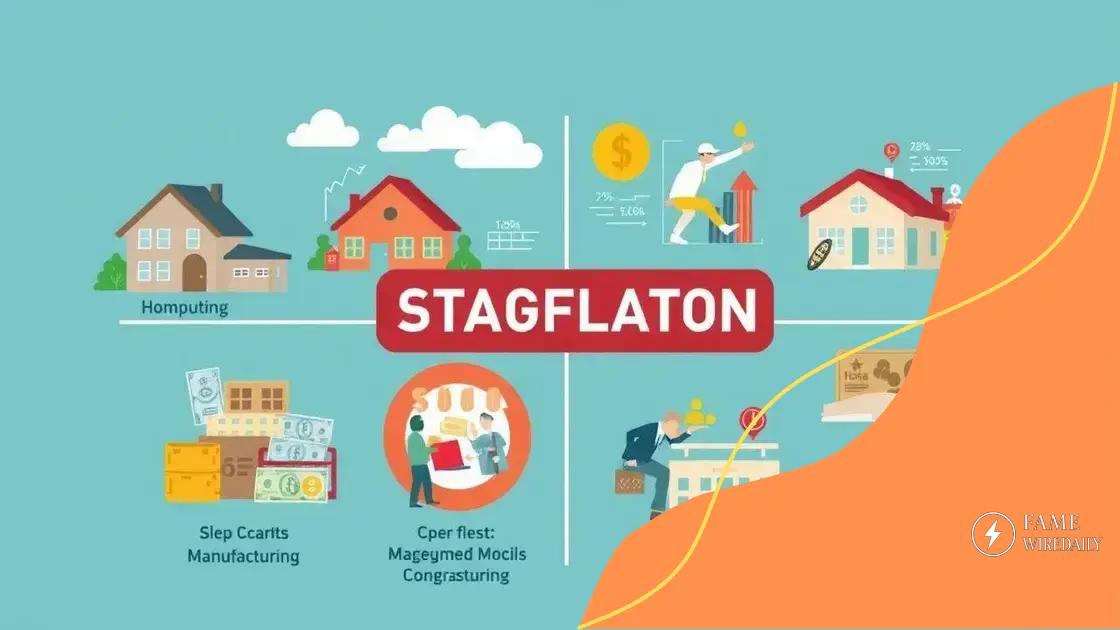Stagflation risk rises: Is your investment strategy safe?

Anúncios
Stagflation is an economic condition characterized by rising inflation and stagnant economic growth, necessitating strategic measures such as diversification and investing in essentials to protect investments.
Stagflation risk rises and it’s crucial for investors to pay attention. With the economy facing challenges, how prepared are you to protect your investments? Let’s dive into what stagflation means for your portfolio.
Anúncios
Understanding stagflation and its implications
Understanding stagflation is critical as it combines stagnation and inflation, creating a complex economic scenario. This phenomenon can have serious consequences for both individuals and businesses. In essence, stagflation leads to rising prices while economic growth halts, making it a difficult situation to navigate.
Historically, periods of stagflation have proven challenging for economies. For instance, the 1970s in the United States showcased this issue, where rising oil prices contributed to stagnant economic growth. During such times, consumers and businesses often face financial strain, giving rise to concerns about employment and purchasing power.
Key Implications of Stagflation
When examining the effects of stagflation, several key aspects emerge:
Anúncios
- Increased Costs: Individuals and business owners may notice that everyday expenses rise, squeezing budgets.
- Investment Challenges: Investors must reassess their strategies as certain sectors may suffer while others thrive.
- Job Market Instability: Employment opportunities can dwindle, leading to higher unemployment rates.
As economic experts frequently analyze stagflation, they focus on various strategies to mitigate its impact. Potential approaches may include adjusting interest rates or creating policies to stimulate growth. Economic policymakers often face difficult decisions that can carry significant ramifications for the population.
Understanding how to react during periods of stagflation can empower individuals. Financial literacy becomes essential in managing resources effectively, as recognizing trends can help in making informed choices.
Conclusion
In summary, stagflation represents a unique and challenging economic climate. Its implications impact various sectors, making awareness and strategic planning vital for navigating such conditions.
Historical context of stagflation events
To grasp the concept of stagflation, it’s essential to explore its historical context. This economic phenomenon gained attention during the 1970s when many countries faced rising inflation and stagnant growth simultaneously. The oil crisis of this period was a significant factor that contributed to these conditions.
During the 1970s, the price of oil surged due to geopolitical tensions and supply disruptions. As a result, energy costs skyrocketed, impacting every aspect of the economy. Consumers felt the pinch, and businesses struggled to cope with increased operational expenses.
Key Historical Events
Several events led to our current understanding of stagflation. Here are key milestones:
- 1973 Oil Crisis: This crisis marked the beginning of the modern stagflation era, as oil prices quadrupled.
- Rising Unemployment: Many industries faced layoffs due to rising costs and reduced demand.
- Government Responses: Policies aimed at curbing inflation often failed to stimulate growth.
As countries battled economic stagnation and inflation, central banks struggled to find solutions that worked. Raising interest rates to control inflation sometimes deepened economic downturns. This period served as a wake-up call for policymakers and economists alike.
Later occurrences of stagflation in different regions reiterated how complex this issue is. Japan, in the 1990s, grappled with a lost decade characterized by stagnant growth and deflation. Similar situations have emerged in various economies, showing the recurring nature of this problem.
Impact of stagflation on various sectors

The impact of stagflation extends across various sectors of the economy. As inflation rises and economic growth slows, each sector faces unique challenges that can threaten stability. For instance, consumers experience higher prices, while businesses struggle to maintain profitability amidst increasing costs.
Different industries feel the effects of stagflation in distinct ways. For example, the energy sector often sees increased demand as prices rise, while retail businesses may suffer from decreased consumer spending. Understanding these impacts helps investors and policymakers prepare for economic shifts.
Sector-by-Sector Analysis
Examining the effects on key sectors reveals the breadth of stagflation‘s reach:
- Housing Market: Higher interest rates combined with rising prices often lead to decreased demand for housing. Buyers may postpone their purchases, negatively impacting real estate.
- Manufacturing: Production costs can soar as raw materials become more expensive. This scenario forces manufacturers to either raise prices or reduce output.
- Consumer Goods: As disposable income shrinks, consumers prioritize essential items over luxury goods. This results in decreased sales for companies reliant on discretionary spending.
- Financial Services: Financial institutions often face challenges with loan defaults and reduced lending, leading to tightened credit markets.
As the economy struggles, understanding the impact of stagflation helps guide strategies for recovery. Companies may need to pivot their business models to address shifting consumer behavior. Those that adapt quickly have a greater chance of surviving turbulent economic times.
In summary, the ramifications of stagflation on various sectors present obstacles that are challenging yet manageable. Knowledge of these impacts is essential for navigating the complexities of an unstable economic environment.
Strategies to safeguard investments during stagflation
During times of stagflation, safeguarding your investments becomes crucial. As inflation continues to rise while economic growth stagnates, investors need to be strategic about where they place their money. Several approaches can help protect portfolios from the unpredictable nature of this economic climate.
Diversification
One of the most effective ways to safeguard investments is through diversification. By spreading investments across different asset classes, investors can mitigate risks associated with stagflation. This means including stocks, bonds, real estate, and commodities within a portfolio, which can help balance out potential losses in any single area.
Investing in Real Assets
Real assets, such as real estate and precious metals, tend to hold their value even during periods of inflation. Investing in these tangible assets can provide a hedge against rising prices. For instance, real estate often appreciates in value, while gold and silver can act as a safe haven for capital.
Focus on Essential Goods
Goods that are essential to daily life, such as food, healthcare, and consumer staples, typically maintain demand even during recessions. Investing in companies that produce these essential goods can offer more stability. Consider focusing on:
- Consumer staples: Products like toiletries and groceries are consistently needed.
- Healthcare: Pharmaceuticals and medical devices tend to be resilient.
- Utilities: Energy and water services generally see steady demand.
Another strategy is to assess bonds, especially inflation-protected securities. These bonds adjust in value with rising inflation, providing a safeguard on fixed income. By evaluating opportunities in treasury inflation-protected securities (TIPS), investors can help protect their purchasing power.
Lastly, maintaining liquidity is vital. Keeping a portion of investments in cash or cash-equivalents ensures access to funds during uncertain times. This liquidity allows for flexibility to purchase opportunities that arise during market downturns.
Future outlook on stagflation risks and recovery
The future outlook for stagflation carries significant uncertainty as economies around the world face ongoing challenges. Events such as global conflicts, supply chain disruptions, and changes in energy prices can all contribute to this risk. Understanding potential scenarios will help businesses and investors prepare for what lies ahead.
Many economists believe that stagflation could reemerge if inflation remains unchecked while growth slows. Central banks are facing a delicate balance in managing interest rates to combat inflation without triggering further economic downturns. The actions they take will be crucial in shaping future outcomes.
Potential Recovery Paths
Looking ahead, there are possible paths for recovery from stagflation. These include:
- Fiscal Stimulus: Governments may inject money into the economy through infrastructure projects and job creation initiatives. This can stimulate growth and potentially reduce inflation.
- Supply Chain Improvements: Enhancing efficiency in supply chains can stabilize prices and mitigate the factors contributing to stagflation. Companies that adapt quickly to these changes may thrive.
- Technological Advancements: Innovation can drive productivity, leading to economic growth even in challenging environments. Investing in new technologies can benefit sectors that traditionally struggle.
- Global Cooperation: International collaboration can help stabilize markets and reduce economic volatility. Countries working together to tackle inflation and trade issues can create a more resilient global economy.
The long-term impact of stagflation will largely depend on how policymakers and businesses respond to current economic challenges. Continuous monitoring of economic indicators will be vital to navigate this intricate landscape.
As stakeholders adjust to the evolving situation, the resilience of both businesses and consumers will play a significant role in economic recovery. Exploring various scenarios will help prepare for potential future outcomes regarding stagflation risks.
FAQ – Frequently Asked Questions about Stagflation
What is stagflation?
Stagflation is an economic condition where inflation rises while economic growth stagnates, leading to high prices and low growth.
How can I safeguard my investments during stagflation?
Investors can diversify their portfolios, invest in essential goods, and focus on real assets to protect their investments from stagflation.
What sectors are most affected by stagflation?
Sectors like housing, manufacturing, consumer goods, and financial services can experience significant impacts during stagflation due to rising costs and decreased demand.
What strategies might help economies recover from stagflation?
Recovery strategies may include fiscal stimulus, improving supply chains, embracing technological advancements, and fostering global cooperation.





